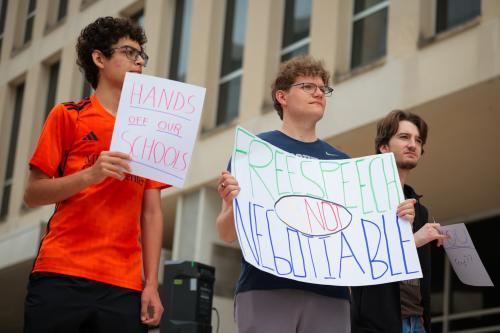On March 9, 2012, the two major gangs, Mara Salvatrucha 13 (MS-13) and the Barrio 18, whose origins date back to the incarcerated Salvadoran and Mexican population in the jails of Los Angeles, reached a truce. From their headquarters in the maximum security jails of El Salvador, they instructed their members to desist in murdering each other. They also agreed with the government to constrain their members from killing law enforcement officers. While not explicitly admitting participation, the government offered to work on preventing youth from joining these gangs, known as maras, and assist in reintegrating them into regular employment. The government also transferred the leaders to medium security prisons, admitted cell phone communication and allowed conjugal visits. No discussion on drug use or trafficking occurred, because the MS-13 and Barrio 18 avoid direct trafficking in illicit drugs and impose strict discipline on their members to avoid drug use while working.
Monsignor Fabio Colindres initiated the talks and continues to play the role of mediator between the parties. The result of this truce was a significant reduction in the national’s homicide rate from 14 per day to five per day. Nearly 15 months later, the truce still holds, but three questions arise: Has real peace arrived in El Salvador? What are the consequences of this agreement? And can an equivalent agreement be replicated in Guatemala and Honduras?
Homicides in El Salvador have fallen, but the rate of extortions has stayed the same, if not increased. To stay in business, the mareros have increased their revenue by demanding weekly payments both from women selling tortillas on street corners to the employees of medium-sized enterprises sewing apparel. A recent visit to San Salvador reveals that fear still pervades society. The wealthy continue to hire private security and drive in bulletproof cars; the majority of lower-middle class and poor people are the constant victims of extortion. Many have closed up their business and other seek to migrate to safer places, including the United States. Extortion extends to the family members of young Salvadorans living in Northern Virginia who are required to make weekly payments to one or other maras if they wish for their parents, or close family members, to remain safe in El Salvador.
In September 2012, Carlos Mójica Lechuga, the leader of Barrio 18, told the press that commissions from the MS-13 and Barrio 18 in Honduras and Guatemala had visited him in El Salvador to understand the negotiations with a view to replicating the process. This would require leadership from within civil society of each nation, as well as a mediator with the credibility and persistence of Monsignor Colindres. Mójica stressed the advantages, including the recognition of MS-13 and Barrio 18 leaders as political players. These men were no longer treated as ostracized gang members, but representatives of powerful organizations wielding political power through their negotiations. Around the same time, the Honduran and Guatemalan ministers with responsibility for public security also met in San Salvador to understand the process and the implications of reaching a non-aggression pact.
On May 24, 2013, both the Honduran MS-13 and the Barrio 18 publicly renounced killing, kidnapping and extortion. They held two separate press conferences within the same Honduran jail and each made distinct commitments based on their relative strength and capacity to control their followers. Leaders of the Barrio 18 stated that they would cease violent acts if the government listened to them and “if the police stop killing us.” However, they could not, at this stage, agree to stop extortion, a major source of funding for the organization. On that same day, the relatively weaker mara, the MS-13 announced that they would desist from killing, kidnapping and extortion. Their leader offered “zero violence.” The instruction was to take effect immediately. Should we expect the same decline in homicide rates?
Considerable skepticism exists within Honduras. Unlike in El Salvador, crime is not controlled by two dominant maras, but rather by networks of street gangs, known as cliques. In the absence of centralized leadership, it is doubtful that the cliques will be able to control the behavior of their members. Nevertheless, a dedicated Catholic prelate, Bishop Romulo Emiliani, and Organization of American States (OAS) representative Adam Blackwell are determined to build upon these early announcements. Emiliani denies that any formal agreement has been reached with the Honduran MS-13 and Barrio 18. In his words, the prospect of a truce remains for the future.
The situation in Guatemala is also distinct from that of El Salvador. Major narcotic traffickers, such as the Mexican Zetas and the Knights Templar control the drug trafficking routes and rarely bother with national cliques, except for some local sales. According to a senior official in the Ministerio de Gobernacion, only 2 percent of homicides in 2012 were drug related, 63 percent were attributed to murder among cliques or failure to pay extortion. Instead, street gangs formed by a half a dozen young men and their girl friends, sisters or mothers dominate 25 Guatemalan municipalities. Extortion is their principal activity: demanding rents which range from $10 to $1,000 a week. Male members telephone, or directly impose the demand: females collect the monies. Failure to pay results in assassination. Failure to collect the monies results in the killing and distribution of female breast or genital tissue to family members. Working as a network, the cliques move quickly and quietly from locality to locality avoiding law enforcement, but retaining their “client base” from which to extort. Conflict between cliques is intense as each seeks to retain control over its client base. Furthermore, these cliques are notorious for the youthfulness of their members. It is not uncommon for a 12 year old to be an active member, having passed into the clique through the ritual known as “brinco,” which often requires killing.
These cliques are not subsumed within the MS-13 or Barrio 18. Indeed, the capacity of the two major maras to impose discipline on Guatemalan cliques is minimal. Therefore, the Minister of Government is skeptical of the effectiveness of any non-aggression pact or truce, similar to that reached in El Salvador.
How then should the Guatemalan government react to this economic dependence on violence that is not based on drug trafficking, but rather on cliques profiting from extortion? There also exists the fear that if the perpetrator of crime fails to carry out his assigned task, he or she will become the victim. To date, the governments of El Salvador, Honduras and Guatemala have responded by increasing state recourses devoted to security and justice. This is necessary, but greater focus needs to be placed on social services: health, education, and job training. The World Bank calculates that 30 percent of urban youth aged 15 to 24 years in Central America are neither at school nor working. Youth training programs are key to providing young people with basic skills to improve their chances of finding a job. Furthermore, according to the Guatemalan think tank, FUNDESA, 43 percent of Guatemalan children suffer from chronic malnutrition affecting their capacity to learn. Among Guatemalan students, the median number of years in school is 4.1. Poor health and inadequate education must be addressed if the pool of young recruits to the cliques is to end. As the Guatemalan president considers whether to engage in negotiations to constrain the violence, investment in basic health and education must assume a priority. Otherwise, the disintegration of Guatemalan’s young will continue.
The Brookings Institution is committed to quality, independence, and impact.
We are supported by a diverse array of funders. In line with our values and policies, each Brookings publication represents the sole views of its author(s).



Commentary
MS-13 and Barrio 18 Truce: Can This Be Successfully Replicated in Honduras and Guatemala?
June 5, 2013